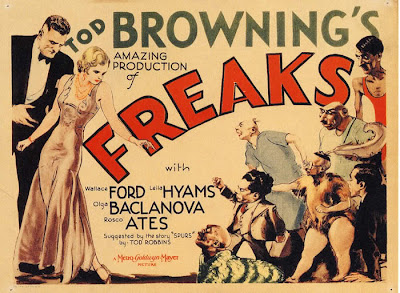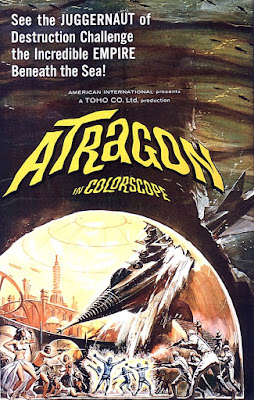(1957) Directed by Terence Fisher; Written by: Jimmy Sangster; Based on the Novel by Mary Shelley; Starring: Peter Cushing, Christopher Lee, Hazel Court and Robert Urquhart.
Available on DVD.
Rating: **** ½
Starting with Thomas Edison’s version of Frankenstein in 1910, there have been numerous filmed interpretations of Mary Shelley’s novel about a misguided scientist and his disastrous creation. 1957’s The Curse of Frankenstein was a bold re-telling of Shelley’s seminal story, and represented a major step forward for Hammer horror. More than 25 years after Universal’s iconic version debuted, Hammer Films decided to produce a Frankenstein film for a new generation. Far from a copy of the Universal film, and virtually unrecognizable from Mary Shelley’s original story, The Curse of Frankenstein veered off on its own tangent, introducing mainstream audiences to blood and guts in glorious color. Audiences flocked to see the modestly budgeted film, which eventually grossed $7 million in the U.S. (a tidy sum in the 1950s) and spawned several mostly inferior sequels.
As The Curse of Frankenstein begins, Baron Frankenstein is a condemned man destined for the gallows. He requests the company of a priest, not for solace in his final hours, but as an opportunity to tell his story to the only one who will listen. This early scene reveals Frankenstein’s ulterior motives. It’s not a confession of his sins, but an attempt to relay the importance of his work.
Peter Cushing plays the singular-minded, almost sociopathic Baron Frankenstein. His unsympathetic Frankenstein is a profound departure from Colin Clive’s tortured portrayal of a scientist who realizes that he has overstepped nature’s laws. In the 1931 version, Frankenstein agonized over the ramifications of the walking horror he had unleashed upon the world. Cushing’s Frankenstein is pure hubris, without any apparent remorse. He refuses to take any responsibility for his creation or the deaths involved. Everyone is a help or a hindrance, with most falling into the latter category. His methodology is completely amoral, blinded by his solitary goal to discover the secrets of creating life, and he’s not above murder in the cause of science. Cushing’s fascinating interpretation of Frankenstein embodies one of the key differences between the Hammer and Universal versions: It’s Frankenstein, and not his creation, who is the star.
Robert Urquhart plays Paul Krempe, Frankenstein’s onetime tutor. Paul serves as the film’s moral center, torn between devotion to his old pupil and revulsion about Frankenstein’s tampering with nature. His attempts to convince Frankenstein that he’s taking a destructive path are ultimately futile. In one scene, Paul struggles with Frankenstein to prevent him from using the brain of a recently deceased colleague, resulting in a damaged brain. Of course, from the Baron’s point of view, it’s Paul’s fault that the brain is ruined.
Hazel Court plays Frankenstein’s cousin and fiancée (yech!) Elizabeth. She’s single-minded in her devotion to Frankenstein, despite his indifference. Her character isn’t given much to do, other than hear Paul’s frequent (and condescending) admonitions to leave for her own good. He doesn’t actually provide any factual basis to get her away from Frankenstein. It’s as if his sense of moral outrage is enough to convince her. After all, she’s far too delicate to handle the truth – or so he reasons. Elizabeth seems content to be the Queen of Denial, ignorant of what’s going on in her future husband’s laboratory, or his nocturnal trysts with his housekeeper Justine (Valerie Gaunt), and happy to maintain her fantasy of future marital bliss.
According to Marcus Hearn and Alan Barnes’ informative book, The Hammer Story, the filmmakers took pains to ensure that their creature did not resemble Jack Pierce’s iconic creation from the Universal Frankenstein films.* They succeeded, thanks to Philip Leakey’s gruesome makeup work, which went through several iterations before he came up with the final version seen in the film. It’s certainly more evocative of a corpse brought to life than Universal’s Frankenstein monster.
* It should be noted that the producers weren’t just trying to be original, but wanted to avoid any potential legal action by Universal.
Christopher Lee has a supporting but significant role as Frankenstein’s creature. It would be nearly impossible to step into Boris Karloff’s shoes, and Lee doesn’t even try. He makes the monster his own, creating a silent presence that’s alternately menacing and pathetic. It’s a credit to Lee’s skilled performance that he manages to evoke sympathy for his character, as a being that’s brought forth into a life that he never asked for. This would prove to be Lee’s only turn as the creature. Subsequent sequels used different actors for the role, along with wildly different variants of the creature design.
The Curse of Frankenstein is remarkably well paced, clocking in at a brisk 82 minutes. Some Hammer films tend to be a bit talky in places, but the story chugs along nicely, providing a nice balance between action and exposition. It remains one of the most unique interpretations of Frankenstein, and is easily among Hammer’s best films. It paved the way for the studio’s further explorations of former Universal horror mainstays utilizing their trademark gothic spin with werewolves, mummies, and of course, Dracula.

































